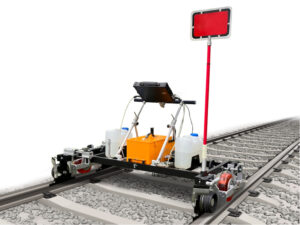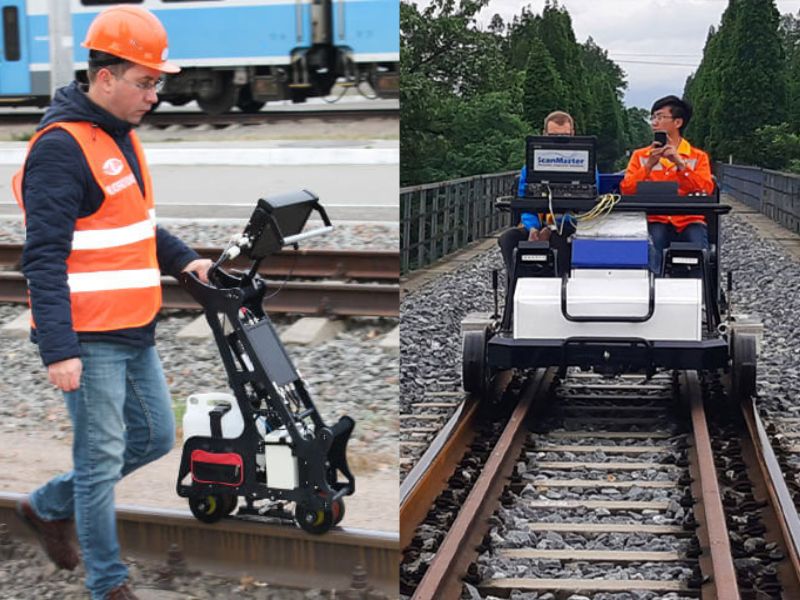The Ultrasonic Rail Detection Cart is revolutionizing the way rail systems are inspected and maintained. In an era where safety and efficiency are paramount, this innovative tool harnesses the power of ultrasonic testing to detect flaws in railway tracks that could lead to serious accidents.
By providing real-time data and insights, the Ultrasonic Rail Detection Cart not only enhances the reliability of rail infrastructure but also streamlines maintenance processes.
As we navigate through 2024, understanding the capabilities and advantages of this technology becomes essential for railway operators committed to ensuring safe and efficient travel for millions of passengers and freight services. So this article will guide you on everything you need to know. Let’s get straight to the details.
What is an Ultrasonic Rail Detection Cart?
An Ultrasonic Rail Detection Cart is a specialized device used for inspecting railway tracks. It employs ultrasonic testing technology to identify defects in rail infrastructure. This cart moves along the tracks, providing real-time data on rail conditions.
The role of the cart is crucial in maintaining safety and reliability. By detecting flaws early, it helps prevent accidents and costly repairs.
Ultrasonic testing has a rich history in railways, dating back to the 1950s. Initially, it was used for weld inspections and has since evolved significantly. Today, it serves as a standard method for assessing track integrity worldwide. Therefore, the Ultrasonic Rail Detection Cart represents a vital advancement in railway maintenance practices.
Key Components of the Ultrasonic Rail Detection Cart

The Ultrasonic Rail Detection Cart is composed of several key components that enhance its functionality and effectiveness in rail maintenance. Understanding these components is essential for appreciating how the cart operates and contributes to railway safety.
From its innovative design to the advanced ultrasonic testing equipment, each element plays a vital role in ensuring accurate inspections and user-friendly operation. Let’s explore these key components in detail.
Cart Design
- Weight and Portability: The Ultrasonic Rail Detection Cart typically weighs between 50 to 100 pounds. This lightweight design allows operators to maneuver the cart easily across various terrains, facilitating efficient inspections. Its compact size enables it to fit into tight spaces, ensuring comprehensive coverage of the railway track without leaving any area uninspected.
- Modular Design: The cart features a modular design that simplifies both setup and breakdown processes. Modular components can be quickly replaced or upgraded as technology evolves, allowing for adaptability to specific inspection needs.
- Ergonomic Features:
- Adjustable handles are designed to accommodate operators of varying heights, promoting comfort during extended use.
- User-friendly controls are strategically placed for easy access, allowing operators to make adjustments on the fly without disrupting the inspection process.
- Cushioned grips help reduce strain during prolonged inspections, minimizing operator fatigue and increasing overall efficiency.
Ultrasonic Testing Equipment
- Types of Ultrasonic Probes:
-
-
- Contact Probes: These probes are commonly used for direct interaction with the rail surface. They are particularly effective in detecting surface and near-surface defects, ensuring that critical flaws are identified during inspections.
- Immersion Probes: Operate in a fluid medium to enhance signal transmission, which improves the quality of inspections. Suitable for more thorough assessments of rail integrity, particularly in challenging environments.
- Angle Beam Probes: Designed to detect flaws at specific angles, offering a more detailed examination of rail conditions.Useful for identifying cracks that may not be visible with standard probes, thereby enhancing the overall detection capabilities of the cart.
- Electronic Unit: Serves as the central processing unit of the detection cart, managing data collection and analysis. Captures ultrasonic signals reflected from the rail, allowing for real-time data processing during inspections. Records measurements immediately, providing operators with timely information about rail conditions as they are inspected.
-
- Data Analysis and Visualization: After data collection, the electronic unit analyzes the ultrasonic signals to identify potential defects. It generates visual representations of findings through graphs and charts, making it easier for operators to interpret results quickly and accurately.
The user interface features a digital display that shows real-time readings and alerts, enabling operators to navigate through inspection data efficiently and respond to any detected issues promptly.
These key components work harmoniously to ensure that the Ultrasonic Rail Detection Cart operates effectively and efficiently, solidifying its status as an invaluable tool in modern railway maintenance.
Also, Ultrasonic rail detection carts make inspections faster and more efficient, but expert testing is still essential. Our ultrasonic examination services detect internal flaws with precision, while our Level III services ensure compliance with industry standards. Keep your railway network safe and reliable with our trusted NDT solutions.
How Ultrasonic Testing Works
Ultrasonic testing relies on high-frequency sound waves to detect flaws in materials. The basic principle involves sending these sound waves into the rail. When the waves encounter a defect, they reflect back to the probe. This reflection provides valuable information about the size and location of the flaw.
Techniques Used in Rail Detection
One common technique is the pulse-echo method. In this method, the ultrasonic probe emits a pulse of sound waves into the rail. When these waves hit a defect, they bounce back to the probe. The time it takes for the waves to return helps determine the defect’s depth and size.
In addition to the pulse-echo method, guided wave technology is also used for broader inspections. This technique sends low-frequency waves along the rail, covering larger areas quickly. Guided wave technology can detect defects that are not easily accessible.
Therefore, it enhances the overall efficiency of rail inspections and ensures comprehensive monitoring of rail integrity.
Advantages of Using Ultrasonic Rail Detection Carts
- Efficiency in Identifying Rail Defects: Ultrasonic Rail Detection Carts excel in quickly identifying various rail defects, including cracks and corrosion. The advanced technology allows for real-time detection, enabling operators to address issues before they escalate. This rapid identification significantly reduces the risk of accidents and enhances overall railway reliability.
- Cost-Effectiveness Compared to Traditional Inspection Methods: These carts provide a more cost-effective solution than traditional inspection methods. By reducing the time required for inspections, they lower labor costs and resource allocation. Additionally, the ability to perform thorough inspections with fewer personnel minimizes operational expenses, making it a financially sound choice for railway operators.
- Improvements in Safety for Both Railways and Operators: The use of Ultrasonic Rail Detection Carts enhances safety for both railways and their operators. Early detection of defects prevents potential accidents, ensuring safer travel for passengers and freight. Moreover, operators experience safer working conditions since the technology reduces the need for manual inspections in hazardous areas, further contributing to a safer railway environment.
Challenges and Limitations
- Technical Challenges: Ultrasonic Rail Detection Carts require operators to have specialized training to use the equipment effectively. This skill requirement can limit the number of qualified personnel available for inspections, potentially delaying necessary maintenance.
- Equipment Limitations: The accuracy of inspections can be affected by various environmental conditions. Factors such as temperature, humidity, and noise levels may interfere with ultrasonic signals, leading to unreliable results. Operators must be aware of these challenges to ensure they obtain accurate data.
- Terrain Restrictions: The design of the cart may present limitations when navigating rough or uneven terrain. In challenging environments, operators may struggle to maneuver the cart effectively, which can hinder inspection efficiency and thoroughness.
- Battery Life Concerns: Battery life can be a significant concern during extended inspections. If the battery depletes quickly, it may interrupt the inspection process and require additional downtime for recharging or replacement. Improving battery technology is essential for enhancing overall performance and usability in the field.
Future Trends in Ultrasonic Rail Detection Technology
Upcoming innovations in ultrasonic testing methods promise to enhance inspection efficiency. One significant trend is the integration of artificial intelligence (AI) into the detection process. AI can analyze data more quickly and accurately, identifying defects that may be missed by human operators.
In addition, automation is set to play a crucial role in future inspections. Automated systems can perform routine checks without human intervention, increasing overall productivity. This shift allows operators to focus on more complex tasks that require human expertise.
Improvements in cart design are also on the horizon. Enhanced mobility features will enable carts to navigate challenging terrains more effectively. This advancement will ensure thorough inspections in previously inaccessible areas.
Furthermore, more advanced data processing capabilities are expected to emerge. These improvements will allow for real-time analysis and immediate reporting of inspection results. Therefore, future trends in ultrasonic rail detection technology will significantly enhance safety and efficiency in railway maintenance.
Final Thoughts
Ultrasonic rail detection carts are vital tools in enhancing railway safety and maintenance efficiency. By utilizing advanced ultrasonic testing technology, these carts enable rapid identification of defects such as cracks and corrosion, significantly reducing the risk of accidents.
Their cost-effectiveness and ability to streamline inspection processes allow railway operators to allocate resources more efficiently. Moreover, the ergonomic design ensures that operators can perform their tasks comfortably and safely.
As the railway industry continues to evolve, the importance of these carts in maintaining safe and reliable rail systems cannot be overstated. Ultimately, ultrasonic rail detection carts play a crucial role in safeguarding both passengers and freight, ensuring the longevity and integrity of railway infrastructure.
Key Points
- The Ultrasonic Rail Detection Cart is a specialized device designed for inspecting railway tracks using ultrasonic testing technology.
- It features a lightweight, modular design that enhances portability and ease of use for operators during inspections.
- The cart efficiently identifies various rail defects, including cracks and corrosion, significantly improving maintenance processes.
- Compared to traditional inspection methods, these carts reduce labor costs and resource allocation, making them a financially sound choice for railway operators.
- Utilizing ultrasonic technology enhances safety by enabling early detection of defects, thus preventing potential accidents and ensuring safer travel.
- Operators require specialized training to effectively use the equipment, which can limit the number of qualified personnel available for inspections.
- Environmental factors can interfere with ultrasonic signals, affecting the accuracy of inspections and requiring operators to be vigilant.
- The cart may struggle with mobility on rough or uneven terrain, which can hinder inspection efficiency in challenging environments.
- Upcoming trends include AI integration and automation, which will enhance inspection processes and improve data analysis capabilities.
- Future improvements in cart design are expected to focus on increased mobility and advanced data processing for real-time analysis during inspections.
FAQs
How do Ultrasonic Rail Detection Carts improve railway safety?
By enabling early detection of defects, these carts help prevent accidents and ensure safer travel for passengers and freight.
What future trends are expected in ultrasonic rail detection technology?
Future trends include AI integration, automation in inspections, enhanced mobility features, and advanced data processing capabilities.
Can Ultrasonic Rail Detection Carts operate in all environments?
While designed for versatility, their performance may be affected by extreme weather conditions or challenging terrains.
How do these carts compare to traditional rail inspection methods?
They are generally faster, more accurate, and less labor-intensive than traditional manual inspection methods.
What types of defects can be detected using Ultrasonic Rail Detection Carts?
These carts can detect various defects, including cracks, corrosion, and other structural issues in railway tracks.

